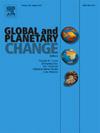Testing Bergmann's rule in marine invertebrates: Using global brachiopod data during the Permian glacial-interglacial transition
IF 4
1区 地球科学
Q1 GEOGRAPHY, PHYSICAL
引用次数: 0
Abstract
Bergmann's rule states that organisms tend to be larger in cold higher latitudinal areas and smaller in warmer lower latitudes, and that this latitudinal gradient of body-size becomes steeper during colder time intervals. Originally formulated for warm-blooded animals, this theory has also been applied to ectotherms. However, few studies have been conducted to examine latitudinal patterns of marine invertebrate body-size, and the idea concerning the latitudinal gradient varying along with overall climate has received little attention. Based on body-size data of 26,112 brachiopods from the Permian glacial-interglacial transition, this paper finds that the latitudinal size distribution of brachiopods followed Bergmann's rule, but the changing pattern of latitudinal gradients along with climate was opposite to that expected in Bergmann's rule.
Except for several specific regions where trends were affected by paleoequatorial currents or there are limited data, brachiopod body-size generally increased as latitude increased. From the colder early Cisuralian (Asselian–Sakmarian) to the warmer Guadalupian, the latitudinal gradient of brachiopod body-size distinctly increased. The starvation-resistance hypothesis may explain this latitudinal pattern of brachiopod body-size and the variation in latitudinal gradients. In higher latitudinal areas, brachiopods tend to grow to larger size to cope with seasonal fluctuation in resource availability, resulting in higher proportion of brachiopods with large body-size in higher latitudinal areas. During the cold ice age, small individuals, which were more abundant in low latitudinal areas, were more vulnerable to, and heavily affected by, the highly seasonal climates. This resulted in heavier losses of small-sized brachiopods in lower latitudinal areas than in high latitudes, and therefore flatter latitudinal gradient of body-size than warmer periods. During the warmer late Cisuralian (Artinskian-Kungurian) and Guadalupian, more small-sized individuals started to flourish in low latitudinal areas, and cool high latitudinal areas with pronounced seasonality still favored large individuals over small ones. The increased proportion of small-sized individuals in lower latitudes then resulted in the steeper latitudinal gradients of brachiopod body-size in warmer periods. Metabolic rate and oxygen solubility have been used to explain the larger body-size of marine invertebrate in higher latitudes in previous studies, but these are considered to have played a less important role in the latitudinal patterns of body-size in this study, since they do not support the result that the latitudinal gradient became steeper when it got warmer.
求助全文
约1分钟内获得全文
求助全文
来源期刊

Global and Planetary Change
地学天文-地球科学综合
CiteScore
7.40
自引率
10.30%
发文量
226
审稿时长
63 days
期刊介绍:
The objective of the journal Global and Planetary Change is to provide a multi-disciplinary overview of the processes taking place in the Earth System and involved in planetary change over time. The journal focuses on records of the past and current state of the earth system, and future scenarios , and their link to global environmental change. Regional or process-oriented studies are welcome if they discuss global implications. Topics include, but are not limited to, changes in the dynamics and composition of the atmosphere, oceans and cryosphere, as well as climate change, sea level variation, observations/modelling of Earth processes from deep to (near-)surface and their coupling, global ecology, biogeography and the resilience/thresholds in ecosystems.
Key criteria for the consideration of manuscripts are (a) the relevance for the global scientific community and/or (b) the wider implications for global scale problems, preferably combined with (c) having a significance beyond a single discipline. A clear focus on key processes associated with planetary scale change is strongly encouraged.
Manuscripts can be submitted as either research contributions or as a review article. Every effort should be made towards the presentation of research outcomes in an understandable way for a broad readership.
 求助内容:
求助内容: 应助结果提醒方式:
应助结果提醒方式:


